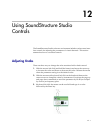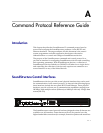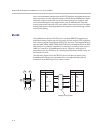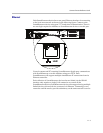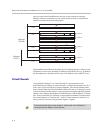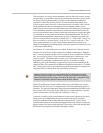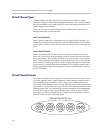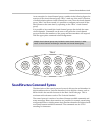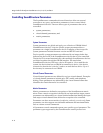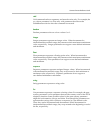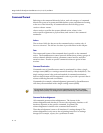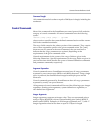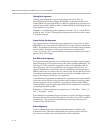
Command Protocol Reference Guide
A - 5
The motivation for using virtual channels is both to allow the control system
programming to start before the physical wiring may be known and to make
the control system programming re-usable across different installations
regardless of how the system is wired. Virtual channels allow third-party
control system code to be easily re-used because the controller code controls
the SoundStructure devices through the virtual channel names, not the
underlying physical input and output that a particular channel is connected to.
Virtual channels make the solution more portable and reusable because the
control system doesn’t need to know which physical input or output the signal
is connected to, it only needs to know the virtual channel name. The use of
virtual channels should also improve the quality of the control system code
since it is more difficult to confuse “Podium mic” vs. “VCR audio” in the code
than it would be to confuse input 7 on device 2 vs. input 9 on device 1. The
clarity and transparency of the virtual channel names should reduce the
amount of debugging and subsequently reduce the amount of time to provide
a fully functional solution.
For instance, if a virtual channel were called “Podium mic” then the control
system code would control this channel by sending commands to “Podium
mic”. It would not matter to the control system if on one installation “Podium
mic” were wired to input 1 and on another installation “Podium mic” was
wired to input 7. The same control system code can be used on both
installations because the SoundStructure devices would know which
underlying physical channel(s) are part of the virtual channel definition. By
using the same API commands on different installations that refer to “Podium
mic”, the control system code is insulated from the actual physical connections
which are likely to change from one installation to the next.
Within SoundStructure Studio and any third-party controller code, virtual
channels are the only way to configure and control the underlying physical
channels. The physical input and output channel numbering described in the
previous section is used only in the definition of virtual channels so that the
virtual channel knows which physical channel(s) it refers to.
A benefit of working with virtual channels is that stereo signals can be more
easily used and configured in the system without having to manually
configure both the left and right channels independently. Using virtual
channels that represent stereo physical signals reduces the chance of improper
signal routings and processing selections. The result is that both designs and
installations can happen faster and with higher quality.
Warni ng
Virtual channels are a high-level representation that encompasses information
about the physical channel and are used to configure and control the underlying
physical channel(s) without having to know which physical input or output the virtual
channel is connected to after the virtual channel has been defined.



